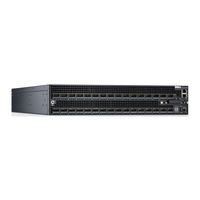Dell Z9000 Manuals
Manuals and User Guides for Dell Z9000. We have 5 Dell Z9000 manuals available for free PDF download: Configuration Manual, Installing, Manual, Quick Start Manual
Dell Z9000 Configuration Manual (968 pages)
10/25/40/50/100GbE throughput
Brand: Dell
|
Category: Network Router
|
Size: 28.05 MB
Table of Contents
-
-
Audience31
-
Conventions31
-
-
-
4 Management
57 -
-
802.1X
82 -
-
IP Prefix Lists109
-
ACL Resequencing113
-
Route Maps115
-
-
-
How BFD Works136
-
BFD Sessions139
-
Configure BFD141
-
-
-
Route Reflectors169
-
BGP Attributes170
-
Weight173
-
Local Preference173
-
Origin175
-
AS Path176
-
Next Hop176
-
-
-
Enabling BGP184
-
-
Debugging BGP220
-
Capturing Pdus222
-
PDU Counters223
-
-
CAM Allocation230
-
Test CAM Usage232
-
View CAM Usage235
-
CAM Optimization235
-
-
-
-
-
Ring Status279
-
-
-
-
-
IGMP Version 2294
-
IGMP Version 3296
-
-
Configure IGMP299
-
Adjusting Timers301
-
IGMP Snooping303
-
-
18 Interfaces
316-
Interface Types317
-
VLAN Interfaces325
-
Null Interfaces326
-
-
-
Link Dampening346
-
Port-Pipes350
-
Dynamic Counters356
Advertisement
Dell Z9000 Configuration Manual (932 pages)
10/25/40/50/100GbE throughput
Table of Contents
-
-
Audience31
-
Conventions31
-
-
-
4 Management
55 -
-
5 1X
76 -
-
IP Prefix Lists106
-
ACL Resequencing111
-
Route Maps113
-
-
-
How BFD Works135
-
BFD Sessions138
-
Configure BFD140
-
-
-
Route Reflectors168
-
BGP Attributes169
-
Weight172
-
Local Preference172
-
Origin174
-
AS Path175
-
Next Hop175
-
-
-
Enabling BGP183
-
-
Debugging BGP220
-
Capturing Pdus222
-
PDU Counters223
-
-
CAM Allocation231
-
Test CAM Usage233
-
View CAM Usage236
-
CAM Optimization237
-
-
-
-
-
Ring Status282
-
-
-
-
-
IGMP Version 2299
-
IGMP Version 3301
-
-
Configure IGMP304
-
Adjusting Timers306
-
IGMP Snooping308
-
-
18 Interfaces
321-
Interface Types322
-
VLAN Interfaces330
-
Null Interfaces331
-
-
Link Dampening347
-
-
Port-Pipes352
-
Dynamic Counters357
-
Advertisement
Dell Z9000 Installing (52 pages)
Brand: Dell
|
Category: Network Hardware
|
Size: 2.1 MB
Table of Contents
Advertisement




